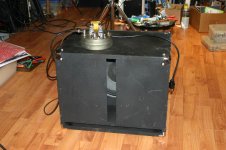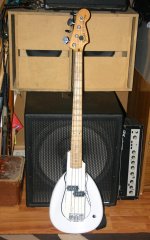jdlech said:I'm also toying with my first project and it also involves a isobaric chamber.
Forgive my ignorance, Tinitus, but am I misunderstanding your musings? An isobaric mid-bass driver? I suppose if one wanted to halve the size of an inner chamber, that would work well enough. But in my ignorance, I see no other reason. Can you?
Thats what its all about, whether there would be any sane reason fore making a 2way isobaric
Sreten points out that my suggestion still misses a second driver fore BSC...so its getting even bigger
Im in serious doubt, but there may be some advantage of the inner compound driver
It may be possible to get better phase between the port and the front driver...I am not sure though
With double front drivers it may be possible to use a bigger compound driver but that could mean trouble...or it could be double clamshell mounted drivers
The inner acoustic connection of the driver may also give some advantage, but a bit uncertain
Well, its beginning to look more like a 3way, or 2.5way with built in sub(no active xo needed😀 )...whether if its worth the effort is hard to tell, but it may not be easy to find the right drivers fore the job
lacrossebowe8 said:
I am interested in isobaric as it presents more of a challenge in construction, and I would like to build something more complicated than a ported, single woofer design.
Attachments
I see what you mean by matching the clamshell with the baffle drivers. I think dual clamshells would be the easiest, though most costly method. Though it might be interesting to see what would happen if the upper chamber was also ported instead of matching it up. Half the vent air movement, two separate Fbs.... Could be used to shore up some response shortcoming.
I've always been leery of upward and downward firing bass drivers, what with gravitys effect on aging spiders and surrounds. Women tend to have the same problem. I'm probably just being anal about it, though. I think I see what you are trying to do with it. Intuition tells me any benefit would come with a high price.
Want to read something funny? I had to look up what a 2.5 way is - and realized it's essentially what I've been banging my head against all this time (3.5 way). Phase matching dissimilar drivers has been a royal b**ch. See figure B for what I'm planning on doing. The group delay is still off the scale though.
See figure B for what I'm planning on doing. The group delay is still off the scale though.
I'm also thinking on acoustically decoupling the iso chamber from the baffle itself. Actually having it mounted on the bottom, and perhaps the sides of the box as well, instead of directly on the baffle. Only lightly compressed foam would make contact between the iso chamber and the baffle. Then perhaps add some sand. That should reduce some resoance.
I've always been leery of upward and downward firing bass drivers, what with gravitys effect on aging spiders and surrounds. Women tend to have the same problem. I'm probably just being anal about it, though. I think I see what you are trying to do with it. Intuition tells me any benefit would come with a high price.
Want to read something funny? I had to look up what a 2.5 way is - and realized it's essentially what I've been banging my head against all this time (3.5 way). Phase matching dissimilar drivers has been a royal b**ch.
 See figure B for what I'm planning on doing. The group delay is still off the scale though.
See figure B for what I'm planning on doing. The group delay is still off the scale though.I'm also thinking on acoustically decoupling the iso chamber from the baffle itself. Actually having it mounted on the bottom, and perhaps the sides of the box as well, instead of directly on the baffle. Only lightly compressed foam would make contact between the iso chamber and the baffle. Then perhaps add some sand. That should reduce some resoance.
Attachments
lacrossebowe8 said:while I am not fixated on building an isobaric design, I would like to try it. I really just want to build a large, standmounted speaker with enough bass to need no sub.
Also, how much harder is a 3 way crossover construction than a two way if I decide to do an isobaric design with a midrange and tweeter?
Isobaric or not, I just want to make one point. If your bookshelf will be seating on the stand, you have roughly the same footprint and you aren’t gaining anything in terms of space saving. You may as well increase the volume of the box and build a floor-standing 2-way loudspeaker. Something similar in proportion to ProAc 2.5 or such. 2.5 btw produce plenty of low end. If you decide to build an isobaric 2-way design, depth will probably have to be increased. Isobaric design greatly reduces linear distortions of the driver. I would be very curious to se the results, because I am designing a 3 way with 2 separate ported enclosures for the woofers in isobaric configuration.
If you are concern with lower frequencies, I think ported box would serve you better.
Hi lacrossebowe8
I know you interest the Isobaric speaker.If you like it you build
it. And if you don't want to lose -3db. I suggest that The MTM
is the best way. +6db that you can get . It 's not has a sub
woofer.
I know you interest the Isobaric speaker.If you like it you build
it. And if you don't want to lose -3db. I suggest that The MTM
is the best way. +6db that you can get . It 's not has a sub
woofer.
I'm thinking I may go with the proteus or similar. Easier construction, more efficient, more information.
The Orange designs have on both speakers 1/4" holes in the cone. Still have issues with voice coil stress. The Trace Elliot design rules, will blow out a lighter @15ft!
Attachments
Last edited:
- Home
- Loudspeakers
- Multi-Way
- Isobaric Designs



